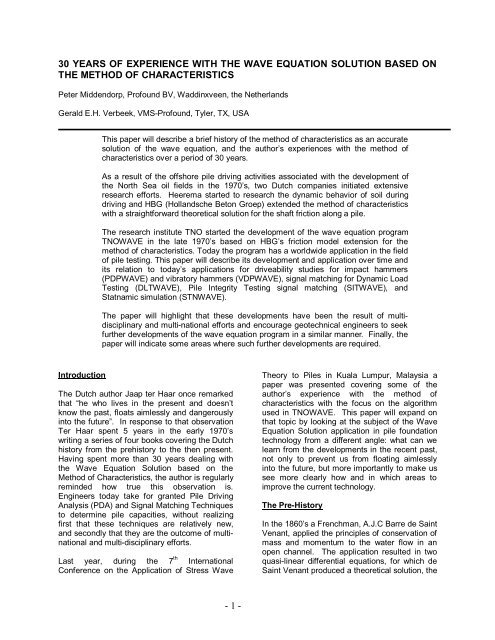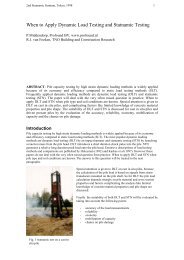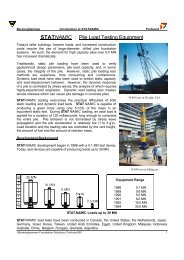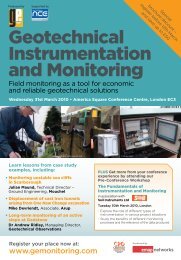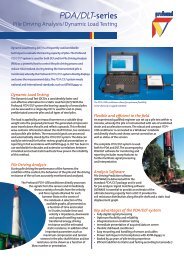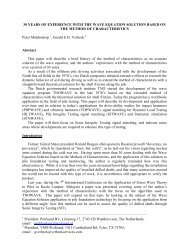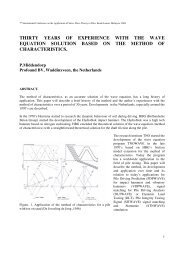1 - 30 years of experience with the wave equation ... - Profound BV
1 - 30 years of experience with the wave equation ... - Profound BV
1 - 30 years of experience with the wave equation ... - Profound BV
You also want an ePaper? Increase the reach of your titles
YUMPU automatically turns print PDFs into web optimized ePapers that Google loves.
<strong>30</strong> YEARS OF EXPERIENCE WITH THE WAVE EQUATION SOLUTION BASED ON<br />
THE METHOD OF CHARACTERISTICS<br />
Peter Middendorp, Pr<strong>of</strong>ound <strong>BV</strong>, Waddinxveen, <strong>the</strong> Ne<strong>the</strong>rlands<br />
Gerald E.H. Verbeek, VMS-Pr<strong>of</strong>ound, Tyler, TX, USA<br />
This paper will describe a brief history <strong>of</strong> <strong>the</strong> method <strong>of</strong> characteristics as an accurate<br />
solution <strong>of</strong> <strong>the</strong> <strong>wave</strong> <strong>equation</strong>, and <strong>the</strong> author’s <strong>experience</strong>s <strong>with</strong> <strong>the</strong> method <strong>of</strong><br />
characteristics over a period <strong>of</strong> <strong>30</strong> <strong>years</strong>.<br />
As a result <strong>of</strong> <strong>the</strong> <strong>of</strong>fshore pile driving activities associated <strong>with</strong> <strong>the</strong> development <strong>of</strong><br />
<strong>the</strong> North Sea oil fields in <strong>the</strong> 1970’s, two Dutch companies initiated extensive<br />
research efforts. Heerema started to research <strong>the</strong> dynamic behavior <strong>of</strong> soil during<br />
driving and HBG (Hollandsche Beton Groep) extended <strong>the</strong> method <strong>of</strong> characteristics<br />
<strong>with</strong> a straightforward <strong>the</strong>oretical solution for <strong>the</strong> shaft friction along a pile.<br />
The research institute TNO started <strong>the</strong> development <strong>of</strong> <strong>the</strong> <strong>wave</strong> <strong>equation</strong> program<br />
TNOWAVE in <strong>the</strong> late 1970’s based on HBG’s friction model extension for <strong>the</strong><br />
method <strong>of</strong> characteristics. Today <strong>the</strong> program has a worldwide application in <strong>the</strong> field<br />
<strong>of</strong> pile testing. This paper will describe its development and application over time and<br />
its relation to today’s applications for driveability studies for impact hammers<br />
(PDPWAVE) and vibratory hammers (VDPWAVE), signal matching for Dynamic Load<br />
Testing (DLTWAVE), Pile Integrity Testing signal matching (SITWAVE), and<br />
Statnamic simulation (STNWAVE).<br />
The paper will highlight that <strong>the</strong>se developments have been <strong>the</strong> result <strong>of</strong> multidisciplinary<br />
and multi-national efforts and encourage geotechnical engineers to seek<br />
fur<strong>the</strong>r developments <strong>of</strong> <strong>the</strong> <strong>wave</strong> <strong>equation</strong> program in a similar manner. Finally, <strong>the</strong><br />
paper will indicate some areas where such fur<strong>the</strong>r developments are required.<br />
Introduction<br />
The Dutch author Jaap ter Haar once remarked<br />
that “he who lives in <strong>the</strong> present and doesn’t<br />
know <strong>the</strong> past, floats aimlessly and dangerously<br />
into <strong>the</strong> future”. In response to that observation<br />
Ter Haar spent 5 <strong>years</strong> in <strong>the</strong> early 1970’s<br />
writing a series <strong>of</strong> four books covering <strong>the</strong> Dutch<br />
history from <strong>the</strong> prehistory to <strong>the</strong> <strong>the</strong>n present.<br />
Having spent more than <strong>30</strong> <strong>years</strong> dealing <strong>with</strong><br />
<strong>the</strong> Wave Equation Solution based on <strong>the</strong><br />
Method <strong>of</strong> Characteristics, <strong>the</strong> author is regularly<br />
reminded how true this observation is.<br />
Engineers today take for granted Pile Driving<br />
Analysis (PDA) and Signal Matching Techniques<br />
to determine pile capacities, <strong>with</strong>out realizing<br />
first that <strong>the</strong>se techniques are relatively new,<br />
and secondly that <strong>the</strong>y are <strong>the</strong> outcome <strong>of</strong> multinational<br />
and multi-disciplinary efforts.<br />
Last year, during <strong>the</strong> 7 th International<br />
Conference on <strong>the</strong> Application <strong>of</strong> Stress Wave<br />
Theory to Piles in Kuala Lumpur, Malaysia a<br />
paper was presented covering some <strong>of</strong> <strong>the</strong><br />
author’s <strong>experience</strong> <strong>with</strong> <strong>the</strong> method <strong>of</strong><br />
characteristics <strong>with</strong> <strong>the</strong> focus on <strong>the</strong> algorithm<br />
used in TNOWAVE. This paper will expand on<br />
that topic by looking at <strong>the</strong> subject <strong>of</strong> <strong>the</strong> Wave<br />
Equation Solution application in pile foundation<br />
technology from a different angle: what can we<br />
learn from <strong>the</strong> developments in <strong>the</strong> recent past,<br />
not only to prevent us from floating aimlessly<br />
into <strong>the</strong> future, but more importantly to make us<br />
see more clearly how and in which areas to<br />
improve <strong>the</strong> current technology.<br />
The Pre-History<br />
In <strong>the</strong> 1860’s a Frenchman, A.J.C Barre de Saint<br />
Venant, applied <strong>the</strong> principles <strong>of</strong> conservation <strong>of</strong><br />
mass and momentum to <strong>the</strong> water flow in an<br />
open channel. The application resulted in two<br />
quasi-linear differential <strong>equation</strong>s, for which de<br />
Saint Venant produced a <strong>the</strong>oretical solution, <strong>the</strong><br />
- 1 -
so-called method <strong>of</strong> characteristics. This<br />
method was <strong>the</strong>n used for a variety <strong>of</strong> hydrology<br />
related issues, such as to predict <strong>the</strong><br />
propagation <strong>of</strong> tidal <strong>wave</strong>s, based on <strong>the</strong> work <strong>of</strong><br />
J. Massau and J.C.Schonfield.<br />
Starting in <strong>the</strong> 19<strong>30</strong>’s Saint Venant’s <strong>equation</strong>s<br />
were applied to pile driving around <strong>the</strong> world,<br />
such as by L.H. Donnell in <strong>the</strong> United States,<br />
D.V. Isaacs in Australia, and W.H. Glanville in<br />
England. In 1938 <strong>the</strong> latter directed <strong>the</strong> first<br />
comprehensive study aimed at understanding<br />
cracking in concrete piles at both <strong>the</strong> top and <strong>the</strong><br />
bottom during pile driving. As part <strong>of</strong> this work,<br />
measurements were taken during pile driving<br />
using what was considered at that time portable<br />
equipment in a construction trailer. As such<br />
Glanville is truly <strong>the</strong> pioneer in <strong>the</strong> field <strong>of</strong> PDA,<br />
as it would take some 18 <strong>years</strong> before similar<br />
work was done in <strong>the</strong> Ne<strong>the</strong>rlands (by A.<br />
Verduin in 1956) and some 25 <strong>years</strong> before it<br />
was done here in <strong>the</strong> United States (by G.G.<br />
Goble in 1964).<br />
Just as Glanville can be considered <strong>the</strong> fa<strong>the</strong>r <strong>of</strong><br />
PDA, Isaacs can be considered <strong>the</strong> first to ever<br />
use <strong>wave</strong> <strong>equation</strong>s for modeling pile driving.<br />
But apart from that, he should also be<br />
remembered for his insights on <strong>the</strong> issue <strong>of</strong><br />
safety factors. In an article published in 1931 in<br />
<strong>the</strong> Journal <strong>of</strong> <strong>the</strong> Institution <strong>of</strong> Engineers<br />
Australia, Isaacs wrote <strong>the</strong> following on this<br />
subject:<br />
It should be remembered, however, that<br />
<strong>the</strong>se are not true factors <strong>of</strong> safety, but<br />
include a "factor <strong>of</strong> ignorance." The<br />
author suggests that when <strong>the</strong> ultimate<br />
resistance <strong>of</strong> any pile has been<br />
determined, in fixing <strong>the</strong> factor <strong>of</strong><br />
safety...<strong>the</strong> most unfavorable conditions<br />
possible in <strong>the</strong> supporting strata should<br />
be judged (<strong>the</strong> range <strong>of</strong> conditions<br />
possible being narrowed <strong>with</strong> better<br />
knowledge <strong>of</strong> <strong>the</strong> subsurface conditions<br />
and <strong>of</strong> <strong>the</strong> possibility <strong>of</strong> disturbance from<br />
extraneous sources) and a proportion <strong>of</strong><br />
<strong>the</strong> factor <strong>of</strong> safety -- a "factor <strong>of</strong><br />
ignorance" -- <strong>the</strong>n allowed in respect to<br />
<strong>the</strong>se possible conditions, <strong>the</strong> manner <strong>of</strong><br />
determining <strong>the</strong> ultimate load, and <strong>the</strong><br />
type <strong>of</strong> loading to be borne. The<br />
remaining proportion <strong>of</strong> <strong>the</strong> factor <strong>of</strong><br />
safety -- or true margin <strong>of</strong> safety --<br />
should be approximately constant for all<br />
classes <strong>of</strong> loading and foundation<br />
conditions involving <strong>the</strong> same value <strong>of</strong><br />
- 2 -<br />
loss in case <strong>of</strong> failure; and <strong>the</strong> overall<br />
factor <strong>of</strong> safety...will <strong>the</strong>n be equal to <strong>the</strong><br />
product <strong>of</strong> <strong>the</strong> true factor <strong>of</strong> safety <strong>with</strong><br />
<strong>the</strong> "factor <strong>of</strong> ignorance." (p. <strong>30</strong>5)<br />
This way <strong>of</strong> dealing <strong>with</strong> safety factors was and<br />
remains extremely insightful, and is just ano<strong>the</strong>r<br />
example why it is important to know <strong>the</strong> past.<br />
The original method <strong>of</strong> characteristics was valid<br />
for a free rod, not interacting <strong>with</strong> shaft friction or<br />
toe resistance. After all, <strong>the</strong> method is based on<br />
<strong>the</strong> phenomenon that stress <strong>wave</strong>s propagate<br />
unaltered <strong>with</strong> a characteristic stress <strong>wave</strong><br />
velocity. In 1956 Dutch scientist G. de Josseling<br />
de Jong proposed a model to incorporate <strong>the</strong> toe<br />
resistance into <strong>the</strong> method <strong>of</strong> characteristics<br />
(Fig. 1), and <strong>the</strong>n in 1974 <strong>the</strong> Dutch company<br />
HBG extended <strong>the</strong> method by formulating <strong>the</strong><br />
<strong>the</strong>oretical solution for piles <strong>with</strong> shaft friction.<br />
This development was part <strong>of</strong> HBG’s<br />
development <strong>of</strong> <strong>the</strong> Hydroblok impact hammer, a<br />
high-tech hammer using nitrogen cushioning to<br />
improve efficiency.<br />
Until 1974 when friction was introduced, <strong>the</strong><br />
partial differential <strong>equation</strong> could only be solved<br />
analytically if <strong>the</strong> friction was represented as an<br />
analytical function. The solution was <strong>the</strong>n found<br />
by integral transforms (such as <strong>the</strong> Laplace<br />
transform) and obtained in <strong>the</strong> form <strong>of</strong> Fourier<br />
series (Van Koten, et al. 1980). However, if <strong>the</strong><br />
shaft friction was assumed to depend on <strong>the</strong><br />
velocity or displacement, <strong>the</strong>re was no<br />
<strong>the</strong>oretical solution and a numerical integration<br />
<strong>of</strong> <strong>the</strong> differential <strong>equation</strong> had to be used, as<br />
was done at that time in <strong>the</strong> numerical <strong>wave</strong><br />
<strong>equation</strong> program developed by E.A.L. Smith.<br />
For this purpose <strong>the</strong> pile was modeled by a<br />
number <strong>of</strong> point masses, <strong>with</strong> <strong>the</strong> shaft friction<br />
and toe resistance introduced through a series<br />
<strong>of</strong> springs <strong>with</strong> dash-pots connected to <strong>the</strong> point<br />
masses (<strong>the</strong> so-called Lumped Model, Fig. 2).<br />
Fig. 1. Toe resistance model for method <strong>of</strong><br />
characteristics for low and high<br />
frequencies proposed by De Josseling de<br />
Jong (1956)
foundation pile testing <strong>with</strong> state-<strong>of</strong>-<strong>the</strong>-art<br />
technology that was developed in research and<br />
development projects.<br />
In <strong>the</strong> 1970’s this group started to really focus on<br />
<strong>the</strong> field <strong>of</strong> stress <strong>wave</strong> applications when two<br />
Dutch companies (Heerema and HBG) toge<strong>the</strong>r<br />
<strong>with</strong> TNO intensified <strong>the</strong>ir research in this area<br />
because <strong>of</strong> <strong>the</strong> <strong>of</strong>fshore pile driving activities<br />
associated <strong>with</strong> <strong>the</strong> development <strong>of</strong> <strong>the</strong> North<br />
Sea oil fields.<br />
Fig. 2. Wave Equation Models<br />
To be able to generate a <strong>the</strong>oretical solution, <strong>the</strong><br />
HBG took a different approach to account for <strong>the</strong><br />
friction, which – <strong>with</strong> hindsight – was really very<br />
simple: “when <strong>the</strong> friction is concentrated at a<br />
number <strong>of</strong> points, <strong>the</strong> parts <strong>of</strong> <strong>the</strong> pile between<br />
<strong>the</strong>se points are not subject to friction and <strong>the</strong><br />
simple stress <strong>wave</strong> <strong>the</strong>ory is valid for <strong>the</strong>m”, and<br />
<strong>the</strong> discontinuities that occur at <strong>the</strong> points where<br />
<strong>the</strong> friction is modeled can be easily dealt <strong>with</strong>.<br />
This method formed <strong>the</strong> basis for HBG’s<br />
computer program PILEWAVE that was<br />
released in 1974, a few <strong>years</strong> before <strong>the</strong> WEAP<br />
program was released in <strong>the</strong> USA and<br />
TNOWAVE was released in The Ne<strong>the</strong>rlands.<br />
TNOWAVE<br />
Although it is a small country, The Ne<strong>the</strong>rlands<br />
has a huge piling market because <strong>of</strong> <strong>the</strong> poor<br />
soil conditions. Every year between 700,000<br />
and 1,000,000 pre-cast piles are driven and a<br />
similar number <strong>of</strong> cast in situ piles are installed.<br />
It is <strong>the</strong>refore not surprising that <strong>the</strong>re was a<br />
need for basic research in <strong>the</strong> area <strong>of</strong> pile<br />
foundations. Consequently in <strong>the</strong> 1960’s a<br />
group was established <strong>with</strong>in <strong>the</strong> Building and<br />
Construction Research Department <strong>of</strong> <strong>the</strong> Dutch<br />
organization for Applied Scientific Research<br />
(TNO), <strong>the</strong> second largest R&D organization in<br />
Europe. The Foundation Pile Diagnostic<br />
Systems (FPDS) Group, as it was initially called<br />
before it was renamed Pr<strong>of</strong>ound, took on a<br />
broad range <strong>of</strong> activities for its clients in<br />
In 1975 Heerema performed research at <strong>the</strong><br />
TNO laboratories to investigate soil behavior<br />
during pile driving to develop models for pile<br />
driveability analysis, elaborating on <strong>the</strong> work<br />
done by H.M. Coyle and G.C. Gibson in <strong>the</strong><br />
United States. At <strong>the</strong> same time HBG used <strong>the</strong><br />
stress-<strong>wave</strong> application in <strong>the</strong>ir development <strong>of</strong><br />
<strong>the</strong> Hydroblok, which lead to <strong>the</strong> release <strong>of</strong><br />
PILEWAVE in 1974.<br />
Following <strong>the</strong> release <strong>of</strong> PILEWAVE, TNO<br />
wanted to develop its own <strong>wave</strong> <strong>equation</strong><br />
program. While it was considered to use<br />
Smith’s algorithm as <strong>the</strong> basis for such a<br />
program, it was decided to use <strong>the</strong> method <strong>of</strong><br />
characteristics instead, and <strong>the</strong> first issue <strong>of</strong> <strong>the</strong><br />
program TNOWAVE was released in 1978. In<br />
<strong>the</strong> following <strong>years</strong> much work was done to<br />
better understand <strong>the</strong> dynamic soil model<br />
parameters and to establish signal matching<br />
techniques, similar to CAPWAP. The first<br />
commercial version <strong>of</strong> <strong>the</strong> DLTWAVE module<br />
was released in 1982.<br />
In <strong>the</strong> second half <strong>of</strong> <strong>the</strong> 1980’s TNOWAVE was<br />
extended to vibratory pile driving prediction,<br />
again in response to developments in <strong>the</strong><br />
<strong>of</strong>fshore oil & gas industry. At that time <strong>the</strong><br />
<strong>the</strong>ories to predict <strong>the</strong> performance <strong>of</strong> a vibrohammer<br />
were based on a single, lumped-mass<br />
pile model. This approach is valid for relatively<br />
short piles, but not for long piles (such as used<br />
<strong>of</strong>fshore). A long pile is not moving as a single<br />
lumped mass, and stress <strong>wave</strong> phenomena<br />
have to be taken into account. Using <strong>the</strong> method<br />
<strong>of</strong> characteristics <strong>the</strong> VDPWAVE module was<br />
developed, and following its release in 1988 it<br />
was used to demonstrate that long <strong>of</strong>fshore piles<br />
could be installed <strong>with</strong> vibro-hammers (Jonker &<br />
Middendorp, 1988).<br />
From <strong>the</strong> above it is obvious that <strong>the</strong> early<br />
development <strong>of</strong> TNOWAVE was heavily affected<br />
by <strong>the</strong> <strong>of</strong>fshore oil & gas industry (just as <strong>the</strong><br />
- 3 -
United States Federal Highway Administration<br />
and <strong>the</strong> New York Department <strong>of</strong> Transportation<br />
had a strong influence on <strong>the</strong> development <strong>of</strong><br />
<strong>the</strong> WEAP program in <strong>the</strong> United States). By<br />
<strong>the</strong> late 1980’s and early 1990’s <strong>the</strong>re were<br />
several features added to <strong>the</strong> program to<br />
address needs in <strong>the</strong> pile foundation industry in<br />
general.<br />
First, <strong>the</strong> Dutch pre-cast piling industry wanted<br />
to know <strong>the</strong> minimum amount <strong>of</strong> steel required<br />
to allow pile driving <strong>with</strong>out loss <strong>of</strong> quality and<br />
reliability. Since <strong>the</strong> main function <strong>of</strong> <strong>the</strong><br />
reinforcement is to prevent or at least reduce<br />
cracking during pile driving, a numerical crack<br />
model was developed and implemented into<br />
TNOWAVE in 1988. This model contains <strong>the</strong><br />
following options:<br />
q Simultaneous <strong>wave</strong> propagation in <strong>the</strong><br />
concrete and <strong>the</strong> reinforcement<br />
q Bond forces between concrete and<br />
reinforcement<br />
q Pre-stressing<br />
q Cracking models<br />
q Multiple cracking<br />
q Opening and closing <strong>of</strong> cracks<br />
Secondly, around that same time <strong>the</strong><br />
TNOWAVE signal matching technology was<br />
extended to pile integrity testing, and in 1988 <strong>the</strong><br />
SITWAVE module was released. Later that year<br />
<strong>the</strong> module was successfully tested on piles <strong>with</strong><br />
known defects.<br />
Finally, in <strong>the</strong> early 1990’s <strong>the</strong> program was<br />
expanded one more time <strong>with</strong> <strong>the</strong> release <strong>of</strong> <strong>the</strong><br />
STNWAVE module to cover <strong>the</strong> development <strong>of</strong><br />
Statnamic testing, which was developed by TNO<br />
and Berminghammer. It is interesting to note<br />
that this module strictly speaking doesn’t belong<br />
in TNOWAVE. Given <strong>the</strong> long duration <strong>of</strong> <strong>the</strong><br />
Statnamic test (compared to a dynamic load<br />
test) it was first assumed and later demonstrated<br />
that <strong>the</strong> pile could be modeled as a lumped<br />
mass <strong>with</strong> springs and that stress <strong>wave</strong><br />
phenomena did not have to be taken into<br />
account.<br />
The Present and <strong>the</strong> Future<br />
It is clear that <strong>the</strong> stress-<strong>wave</strong> programs, such<br />
as TNOWAVE and WEAP, have allowed and<br />
continue to allow lowering <strong>of</strong> <strong>the</strong> pile foundation<br />
costs. First, through <strong>the</strong> simulation mode it<br />
provides engineers <strong>the</strong> opportunity to optimize<br />
<strong>the</strong> design <strong>of</strong> both <strong>the</strong> pile itself and <strong>the</strong> pile<br />
foundation. Secondly, through <strong>the</strong> signal<br />
matching mode it allows <strong>the</strong> widespread use <strong>of</strong><br />
dynamic load testing as well as Statnamic<br />
testing, which provide valuable information on<br />
<strong>the</strong> pile bearing capacity and <strong>the</strong>refore enable<br />
even fur<strong>the</strong>r optimization <strong>of</strong> <strong>the</strong> pile foundation<br />
design.<br />
With <strong>the</strong> full implementation in 2007 <strong>of</strong> <strong>the</strong> Load<br />
and Resistance Factor Design (LRFD)<br />
methodology as mandated by <strong>the</strong> Federal<br />
Highway Administration, pile testing will become<br />
more widespread, and stress-<strong>wave</strong> program<br />
applications are <strong>the</strong>refore likely to increase in<br />
<strong>the</strong> coming <strong>years</strong>.<br />
Ram<br />
Ram<br />
Diesel<br />
Helmet/<br />
Hammer Cap<br />
Insert<br />
Routine<br />
Striker<br />
plates<br />
Hammer<br />
Cushion<br />
Helmet/<br />
Hammer Cap<br />
Insert<br />
Anvil<br />
Hammer<br />
Cushion<br />
Pile Cushion<br />
Splice<br />
Pile Cushion<br />
Splice<br />
Gravity or<br />
o<strong>the</strong>r External<br />
Forces<br />
Follower<br />
Gravity or<br />
o<strong>the</strong>r External<br />
Forces<br />
Follower<br />
Pile<br />
Soil<br />
Model<br />
Pile<br />
Soil<br />
Model<br />
Fig 3. TNOWAVE models for Diesel and Hydraulic Hammers<br />
- 4 -
Ano<strong>the</strong>r current application <strong>of</strong> <strong>the</strong> stress-<strong>wave</strong><br />
programs is <strong>the</strong> optimization <strong>of</strong> hammers and<br />
pile cushions. Pr<strong>of</strong>ound has developed a close<br />
working relationship <strong>with</strong> several hammer<br />
manufacturers around <strong>the</strong> world (such as IHC in<br />
<strong>the</strong> Ne<strong>the</strong>rlands, APE in <strong>the</strong> United States and<br />
Berminghammer in Canada). These<br />
relationships provide Pr<strong>of</strong>ound <strong>with</strong> useful<br />
suggestions to upgrade <strong>the</strong> TNOWAVE program<br />
to meet <strong>the</strong> requirements <strong>of</strong> <strong>the</strong> hammer<br />
manufacturers, and <strong>the</strong>y are likely to be at least<br />
one <strong>of</strong> <strong>the</strong> driving forces behind <strong>the</strong> future<br />
developments <strong>of</strong> <strong>the</strong> programs.<br />
A similarly obvious development will be <strong>the</strong><br />
increased use <strong>of</strong> wireless data transmission.<br />
This will reduce and eventually eliminate <strong>the</strong><br />
need for cables to connect <strong>the</strong> sensors mounted<br />
on <strong>the</strong> piles to <strong>the</strong> workstations, and also allow<br />
remote monitoring <strong>with</strong> data automatically<br />
forwarded from <strong>the</strong> construction site to <strong>the</strong><br />
design <strong>of</strong>fice using cell phones.<br />
Along <strong>the</strong> same lines, <strong>the</strong> need for dedicated<br />
work stations is likely to be eliminated by <strong>the</strong> use<br />
<strong>of</strong> PDA and o<strong>the</strong>r pile testing options that can be<br />
plugged into notebook computers by simple<br />
USB connections.<br />
But apart from that, <strong>the</strong>re will be o<strong>the</strong>r<br />
developments. Some <strong>of</strong> <strong>the</strong>se will be<br />
considered (at least <strong>with</strong> hindsight) so obvious<br />
that future engineers will wonder why it took so<br />
long before such developments took place, just<br />
as it is now blatantly obvious how pile friction<br />
should be dealt <strong>with</strong> in <strong>the</strong> stress-<strong>wave</strong> program.<br />
One area that can never be overlooked is soil<br />
modeling. While <strong>the</strong> TNOWAVE soils<br />
investigation module handles many different<br />
types <strong>of</strong> soil investigations (e.g. CPT, SPT, DMT<br />
and PMT or bore hole results), this part is<br />
undoubtedly <strong>the</strong> weakest link in <strong>the</strong> overall<br />
hammer-pile-soil model. To borrow a phrase<br />
from Isaacs, <strong>the</strong> factor <strong>of</strong> ignorance is <strong>the</strong><br />
greatest in <strong>the</strong> soil modeling, and <strong>the</strong>refore<br />
research efforts should be directed towards this<br />
area, making full use <strong>of</strong> <strong>the</strong> ever increasing<br />
computing capabilities. In this regard <strong>the</strong> efforts<br />
in <strong>the</strong> Ne<strong>the</strong>rlands surrounding <strong>the</strong> Geotechnical<br />
Exchange Format (GEF) should be noted. Soil<br />
investigation data (like CPT results) are<br />
recorded in a standardized digital format (GEF)<br />
and <strong>the</strong> TNOWAVE program can than read<br />
<strong>the</strong>se GEF files, after which <strong>the</strong> soil investigation<br />
module automatically determines <strong>the</strong> soil types<br />
and <strong>the</strong>n converts <strong>the</strong> soil investigation data into<br />
<strong>the</strong> fundamental static and dynamic soil<br />
parameters used in <strong>the</strong> algorithms.<br />
Fig. 4. Soil investigation input module<br />
A second focus area should be <strong>the</strong> application <strong>of</strong><br />
<strong>the</strong> stress <strong>wave</strong> program to pile driving <strong>with</strong><br />
vibratory hammers. While this is a routine<br />
operation, <strong>the</strong>re is a lack <strong>of</strong> measurement data<br />
documenting <strong>the</strong> operation. So in order to bring<br />
VDPWAVE to <strong>the</strong> next level <strong>the</strong>re is a need not<br />
only to collect data during <strong>the</strong> vibratory driving<br />
process, but also to analyze this information and<br />
compare it <strong>with</strong> <strong>the</strong> computer predictions.<br />
As engineers we need to keep pushing <strong>the</strong><br />
envelope for <strong>the</strong>se developments to take place,<br />
but at <strong>the</strong> same time we need to keep a close<br />
eye at o<strong>the</strong>r disciplines. We need to remember<br />
that <strong>the</strong> basic <strong>equation</strong>s used in <strong>the</strong> stress-<strong>wave</strong><br />
programs did not come from geotechnology. In<br />
o<strong>the</strong>r words, <strong>the</strong> next big development may<br />
already be out <strong>the</strong>re, waiting for a geotechnical<br />
engineer to apply it to pile foundations.<br />
Similarly we need to be open to developments<br />
elsewhere in <strong>the</strong> world. In this regard <strong>the</strong><br />
international efforts <strong>of</strong> DFI are to be applauded<br />
and supported. Many engineers work for<br />
companies <strong>with</strong> international operations, which<br />
provides ample opportunity for interaction <strong>with</strong><br />
engineers <strong>of</strong> o<strong>the</strong>r nationalities. The internet<br />
allows easy communication <strong>with</strong> people around<br />
<strong>the</strong> world, ei<strong>the</strong>r through e-mail or message<br />
boards such as Ge<strong>of</strong>orum. Once again, <strong>the</strong><br />
problem at hand may not only have been<br />
encountered by ano<strong>the</strong>r engineer, but <strong>the</strong><br />
solution may already have been developed.<br />
After all, <strong>the</strong> pile driving application <strong>of</strong> <strong>the</strong> <strong>wave</strong><br />
<strong>equation</strong> solution based on <strong>the</strong> methods <strong>of</strong><br />
characteristics is <strong>the</strong> result <strong>of</strong> multi-national and<br />
multi-disciplinary efforts, and any substantial<br />
- 5 -
developments are more than likely to come from<br />
similar efforts like that ra<strong>the</strong>r than from a<br />
narrowly focused effort.<br />
References<br />
Berminghammer, P., Janes, M, 1989, An innovative<br />
approach to load testing <strong>of</strong> high capacity piles,<br />
Proceedings <strong>of</strong> <strong>the</strong> International Conference on Piling<br />
and Deep Foundations, London.<br />
Bielefeld, M.W., Dieterman, H.A., Middendorp, P,<br />
Naaktgeboren, N.M., den Uijl, J.A., 1988, Crack<br />
modelling in concrete piles <strong>with</strong> stress <strong>wave</strong> analysis,<br />
3rd International Conference on The Application <strong>of</strong><br />
Stress Wave Theory on Piles, Ottawa, Canada<br />
Bielefeld, M.W., Middendorp P, 1992, Improved pile<br />
driving prediction for impact hammer and vibratory<br />
hammers.4th International Conference on Stress<br />
Waves, The Hague, Balkema<br />
Bielefeld, M.W., Middendorp, P., 1995, Statnamic<br />
simulation, First International Statnamic Seminar,<br />
Vancouver<br />
Coyle. H.M., Gibson, G.C., 1970, Emperical<br />
damping constants for Sands and Clays. Journal <strong>of</strong><br />
Soil Mechanics and Foundationss Division, ASCE<br />
CUR Report, 1999, Description <strong>of</strong> <strong>the</strong> GEF language<br />
definition. www.geonet.nl , Delft, The Ne<strong>the</strong>rlands<br />
De Josselin De Jong, G. 1956, “Wat gebeurt er in de<br />
grond tijdens het heien” (What happens in <strong>the</strong> soil<br />
during pile driving) De Ingenieur, No. 25, Breda, The<br />
Ne<strong>the</strong>rlands,.<br />
Esposito, G., Courage, WMG, van Foeken, R.J.,<br />
2000, Application <strong>of</strong> Stress Wave Method to<br />
Automatic Signal Matching and to Statnamic<br />
Predictions. Sixth International Stress Wave<br />
Conference, Sao Paulo, Brazil<br />
Glanville, W.H., Grime, G., Fox, E.N., Davies,<br />
W.W., 1938, An Investigation <strong>of</strong> <strong>the</strong> Stresses in<br />
Reinforced Concrete Piles during Driving. Technical<br />
Paper No. 20, British Building Research Station,<br />
London, England<br />
Goble, G.G., Rausche, F., 1976, Wave Equation<br />
Analysis <strong>of</strong> Pile Driving, WEAP Program. U.S.<br />
Department <strong>of</strong> Transportation, Federal Highway<br />
Administration, Washington, DC. Report FHWA-IP-<br />
76-13 (4 Vols.)<br />
Goble, G.G., Rausche, F., 1980, “Pile Driveability<br />
Predictions by CAPWAP”, 1 st Int. Conf. Numerical<br />
Methods in Offshore Piling, pp29-36, ICE, London.<br />
Heerema, E.P., 1979. Relationships between wall<br />
fricition displacement velocity and horizontal stress<br />
in clay and in sand for pile drivability analysis.<br />
Ground Engineering<br />
Hussein, M.H., and Goble, G.G., 2004, “A Brief<br />
History <strong>of</strong> <strong>the</strong> Application <strong>of</strong> Stress-Wave Theory to<br />
Piles”, Practices and Trends in Deep Foundations<br />
2004 (Geotechnical Special Publication No. 125), pp<br />
186 – 201, ASCE, Los Angeles<br />
Isaacs, D.V. 1931, Reinforced Concrete Pile<br />
Formulae, Journal <strong>of</strong> <strong>the</strong> Institution <strong>of</strong> Engineers<br />
Australia, Vol. 3, No. 9, September, pp. <strong>30</strong>5 - 323<br />
Jonker, G., Middendorp, P., 1988, Subsea<br />
installations using vibratory piling hammers, 20th<br />
OTC, Houston, Texas.<br />
Jonker, G. Foeken van, R.J., 2000, Hammer and pile<br />
cushion optimalisation, Sixth International Stress<br />
Wave Conference, Sao Paulo, Brazil.<br />
Koten, H. van, Middendorp P., Brederode P. van,<br />
1980, An analysis <strong>of</strong> dissipative <strong>wave</strong> propagation in<br />
a pile., International Seminar on <strong>the</strong> Application <strong>of</strong><br />
Stress Wave Theory on Piles.<br />
Ligterink, A., van Zandwijk, C., Middendorp,<br />
P.,1990, Accurate vertical pile installation by using a<br />
hydraulic vibratory hammer on <strong>the</strong> Abroath Project,<br />
22 nd OTC, Houston, Texas.<br />
Massau. J., 1914 ,Mémoire sur l’intégration<br />
graphique des équations aux dérivées partielles.<br />
(Note on <strong>the</strong> graphical integration <strong>of</strong> partial<br />
differential <strong>equation</strong>s). Mons.<br />
Middendorp,P., van Brederode, P.J.,1984, Skin<br />
friction models for sand from static and dynamic<br />
laboratory load tests. 2nd International Conference<br />
on The Application <strong>of</strong> Stress Wave Theory on Piles,<br />
Stockholm, Sweden, Balkema.<br />
Middendorp, P., van Zandwijk, C., 1985, Accuracy<br />
and reliability <strong>of</strong> dynamic pile testing techniques.<br />
Proceedings 4th International Conference on<br />
Behavior <strong>of</strong> <strong>of</strong>fshore structures (BOSS), Delft,<br />
Ne<strong>the</strong>rlands.<br />
Middendorp, P., van Weele, A.F, 1986, Application<br />
<strong>of</strong> <strong>the</strong> characteristic stress <strong>wave</strong> method in <strong>of</strong>fshore<br />
- 6 -
practice. Proceedings 3rd International Conference<br />
on Numerical methods in Offshore Pilling, Nantes,<br />
France.<br />
Middendorp, P., Reiding, F.J., 1988, Determination<br />
<strong>of</strong> Discontinuities in Piles by TNO Integrity and<br />
Signal Matching Techniques, 3rd International<br />
Conference on The Application <strong>of</strong> Stress Wave<br />
Theory on Piles, Ottawa, Canada<br />
Middendorp, P, Bielefeld, M.W.1995, Statnamic<br />
Load Testing and <strong>the</strong> Influence <strong>of</strong> Stress <strong>wave</strong><br />
Phenomena, First International Statnamic Seminar,<br />
Vancouver<br />
Saint-Venant. B. de, 1867, Memoire sur le doc<br />
longitudinal de deux barres elastiques, Journal de<br />
Ma<strong>the</strong>matique, 2, ser XII, pp 237-376.<br />
Schonfeld, J.C., 1951, Voortplanting van getijden en<br />
soortgelijke golven (Dutch) Propagation <strong>of</strong> tides and<br />
similar <strong>wave</strong>s. Thesis University <strong>of</strong> Delft, The<br />
Ne<strong>the</strong>rlands<br />
Smith, E.A.L., 1960. Pile Driving Analysis <strong>with</strong> <strong>the</strong><br />
<strong>wave</strong> <strong>equation</strong>. Journal <strong>of</strong> Soil Mechanics and<br />
Foundation Engineering, ASCE, No. 86, August.<br />
TNO-Report 1985-1996, TNOWAVE, Dynamic Load<br />
Testing Signal Matching, Users Manual.<br />
Voitus van Hamme, G.E.J.S.L., Jansz J.W. Bomer<br />
H.,and Arentsen, D., 1974, Hydroblok and Improved<br />
Pile Driving Analysis. De Ingenieur, Vol 86, no 8. pp<br />
344-352, The Ne<strong>the</strong>rlands.<br />
Verduin, A., 1956 “Spanningsmetingen tijdens het<br />
heien verricht aan een drietal heipalen voor Pier 1 de<br />
Waalhaven” (Stress<strong>wave</strong> measurements during <strong>the</strong><br />
driving <strong>of</strong> three piles for Jetty 1 <strong>of</strong> <strong>the</strong> Harbor<br />
(Rotterdam)) TNO Rapport Nr. 341, Delft, The<br />
Ne<strong>the</strong>rlands,.<br />
A Short History <strong>of</strong> <strong>the</strong> Wave Equation for Piles,<br />
www.vulcanhammer.net/<strong>wave</strong>/developm.php<br />
www.ge<strong>of</strong>orum.com<br />
- 7 -


